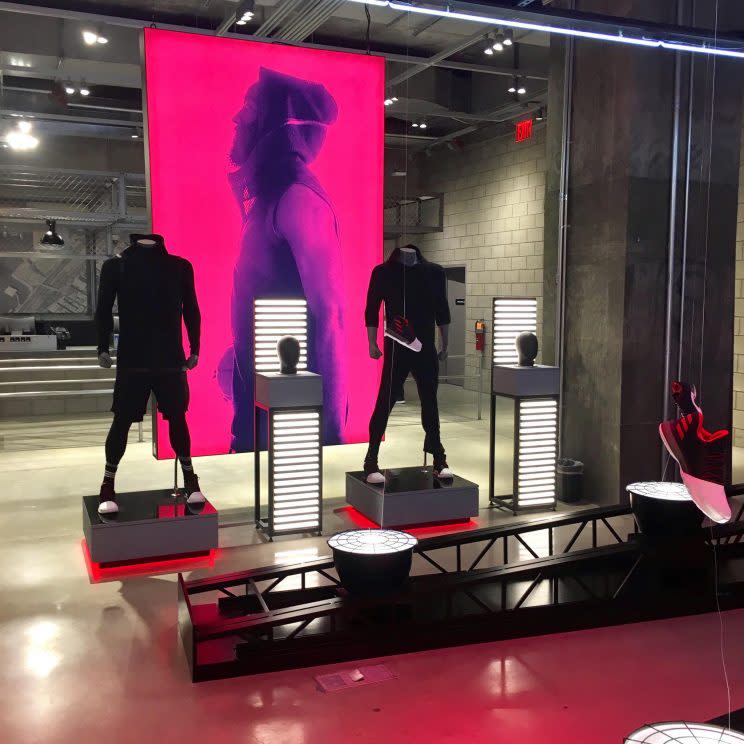Why so many sports brands are opening fancy NYC flagship stores
The new global CEO of German sportswear giant Adidas, Kasper Rorsted, was on hand in Manhattan last week for the grand opening of the brand’s new (and first ever) “flagship” store at 46th Street and Fifth Avenue. At 45,000 square feet, it is the largest Adidas retail store in the world. NBA stars Derrick Rose and Kristaps Porzingis, both sponsored by Adidas, also showed up.
The store opening came just a few months after Under Armour announced it will open a flagship store in the 53,000-square-foot space formerly occupied by FAO Schwarz at 58th Street and Fifth Avenue, next door to the Apple store. Meanwhile Nike plans to open a huge new 70,000-square-foot Niketown store at 52nd Street and Fifth Avenue.
These brand flagship stores are big, showy, and aim for a high-end feel. And they’re opening amid bankruptcy filings by brick-and-mortar sports retail chains like Sports Authority, Bob’s Stores, Eastern Mountain Sports, and Sports Chalet.
What’s going on here?

At a time when more and more consumers may not care to shop at a store in person, brands are trying to entice them with glitzy spaces that focus on the experience, experts say. And the aim of the stores isn’t profit—they typically lose money, especially in locations like Fifth Avenue.
“Brand stores are a way for them to present their products and initiatives without the filter of the retailer and without a competitor’s merchandise nearby,” says NPD Group sneaker analyst Matt Powell. “These stores also allow the brand to enhance and deepen their relationship directly with the consumer.”
That jives with how Adidas US CEO Mark King framed it when asked why the company is opening a fancy flagship store in the midst of a brick-and-mortar death spiral. “I think brands like ours have to decide,” he said, “Do you want to be in the retail business or the consumer business? And I think for us, we’re in the consumer business.”
To be sure, you could argue that a company like Adidas is in both businesses. But King says the “first priority” of the new New York store is “to tell our brand story, showcase our products and interact and engage with consumers on a daily basis. This is an opportunity for us to get closer to the consumer, so it’s a different strategy than your typical retail store.”
The new flagship store gets closer to the consumer through an expansive, flashy ground floor with a “guest kiosk” that offers healthy juice and snacks, a concierge for NYC tips, and an eye-popping display based around NBA star James Harden (it can be swapped out to showcase any Adidas-sponsored athlete). Upstairs, the store has a custom “MiAdidas” area where customers can design their own sneakers.
Adidas devotes the entire upper level to its Originals, the division that houses classic designs like the Superstar and Stan Smith—shoes that have helped the brand claw back share from Nike in the US athletic footwear market. As of October, Nike brand was at 38% not including Jordan and Converse, and Adidas at 7.1%.
It isn’t just individual brands opening up high-end flagship stores. The same type of touches define the new Foot Locker flagship nearby, which opened in August and has a “concept shop” structure, with dedicated rooms for Adidas, Puma, Nike and Jordan Brand, and Six:02, Foot Locker’s women’s apparel shop. “We built this for our kids in New York City,” said Foot Locker North American CEO Jake Jacobs. “It’s really all about our customers and our sneakerheads. What they’re telling us is they want an experience like this. It’s not as much of an assortment game, it’s more of a storytelling game.”
Three blocks down from the new Adidas flagship, The North Face opened up a huge Fifth Avenue flagship store in October. Last year, the NBA did it, opening a flagship merchandise store at 45th Street and Fifth Avenue run by licensing partner Fanatics. It’s the only NBA store in the country.
So it isn’t just individual brands, but also big-box chains and even pro leagues that are looking to the flagship store concept to boost their image with consumers. It’s a different kind of strategy and it banks on the value of a shopping experience. There’s just one problem: many consumers now prefer the experience of just shopping from their computer.
—
Daniel Roberts is a writer at Yahoo Finance, covering sports business and technology. Follow him on Twitter at @readDanwrite. Sportsbook is our recurring sports business video series.
Read more:
3 big reasons sports retail chains are vanishing
How Foot Locker escaped the brick-and-mortar death spiral

 Yahoo Finance
Yahoo Finance 
